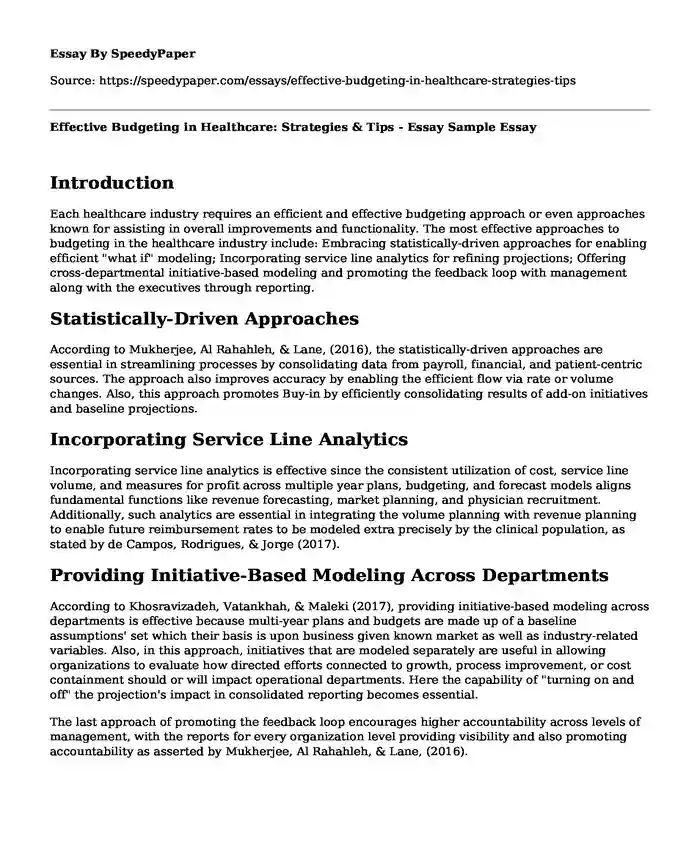
| Type of paper: | Essay |
| Categories: | Medicine Healthcare Budgeting |
| Pages: | 3 |
| Wordcount: | 580 words |
Introduction
Each healthcare industry requires an efficient and effective budgeting approach or even approaches known for assisting in overall improvements and functionality. The most effective approaches to budgeting in the healthcare industry include: Embracing statistically-driven approaches for enabling efficient "what if" modeling; Incorporating service line analytics for refining projections; Offering cross-departmental initiative-based modeling and promoting the feedback loop with management along with the executives through reporting.
Statistically-Driven Approaches
According to Mukherjee, Al Rahahleh, & Lane, (2016), the statistically-driven approaches are essential in streamlining processes by consolidating data from payroll, financial, and patient-centric sources. The approach also improves accuracy by enabling the efficient flow via rate or volume changes. Also, this approach promotes Buy-in by efficiently consolidating results of add-on initiatives and baseline projections.
Incorporating Service Line Analytics
Incorporating service line analytics is effective since the consistent utilization of cost, service line volume, and measures for profit across multiple year plans, budgeting, and forecast models aligns fundamental functions like revenue forecasting, market planning, and physician recruitment. Additionally, such analytics are essential in integrating the volume planning with revenue planning to enable future reimbursement rates to be modeled extra precisely by the clinical population, as stated by de Campos, Rodrigues, & Jorge (2017).
Providing Initiative-Based Modeling Across Departments
According to Khosravizadeh, Vatankhah, & Maleki (2017), providing initiative-based modeling across departments is effective because multi-year plans and budgets are made up of a baseline assumptions' set which their basis is upon business given known market as well as industry-related variables. Also, in this approach, initiatives that are modeled separately are useful in allowing organizations to evaluate how directed efforts connected to growth, process improvement, or cost containment should or will impact operational departments. Here the capability of "turning on and off" the projection's impact in consolidated reporting becomes essential.
The last approach of promoting the feedback loop encourages higher accountability across levels of management, with the reports for every organization level providing visibility and also promoting accountability as asserted by Mukherjee, Al Rahahleh, & Lane, (2016).
Conclusion
Among the discussed approaches, the most effective one is the statistically-driven approaches for enabling efficient "what if" modeling. It is so because it involves a systematic approach by any healthcare organization capable of effectively assessing, monitoring, and improving healthcare quality standards as explained by Kapiriri, & Razavi, (2017). Higher performance levels are sought through continuous improvements through the cyclic chain of activities within the organization. Continuous up-gradation within healthcare activities is capable of effectively pulling out healthcare organizations, particularly from inefficient conventional concepts and utilizing technology or tools to perform efficiently and hence leading to the generation of better quality results (de Campos, Rodrigues, & Jorge, 2017).
References
de Campos, C. M. P., Rodrigues, L. L., & Jorge, S. M. F. (2017). The role of management accounting systems in public hospitals and the construction of budgets: a literature review. In Public Health and Welfare: Concepts, Methodologies, Tools, and Applications (pp. 289-312). IGI Global. https://doi.org/10.4018/978-1-5225-1674-3.ch014
Kapiriri, L., & Razavi, D. (2017). How have systematic priority setting approaches influenced policymaking? A synthesis of the current literature. Health Policy, 121(9), 937-946. https://doi.org/10.1016/j.healthpol.2017.07.003
Khosravizadeh, O., Vatankhah, S., & Maleki, M. (2017). A systematic review of medical service branding: Essential approach to the hospital sector. Annals of Tropical Medicine and Public Health, 10(5), 1137. https://doi.org/10.4103/atmph.atmph_328_17
Mukherjee, T., Al Rahahleh, N., & Lane, W. (2016). The capital budgeting process of healthcare organizations: A review of surveys. Journal of Healthcare Management, 61(1), 58-76. https://doi.org/10.1097/00115514-201601000-00011
Cite this page
Effective Budgeting in Healthcare: Strategies & Tips - Essay Sample. (2023, Sep 16). Retrieved from https://speedypaper.net/essays/effective-budgeting-in-healthcare-strategies-tips
Request Removal
If you are the original author of this essay and no longer wish to have it published on the SpeedyPaper website, please click below to request its removal:
- Free Essay: Sales Techniques and Metrics
- Psychiatric and Mental Health Nursing: Features of the Profession
- Free Essay: Public Health Leadership and a Definition of Systems Thinking
- Pacelle, R. (2018). The role of the Supreme Court in American politics: The least dangerous
- Free Essay Sample on Post-Trauma Stress Disorder Management
- Essay Sample on Emergency Department Ratio Analysis
- Free Essay: Social Class and Race Differences as Determinants of Health and Illness
Popular categories




